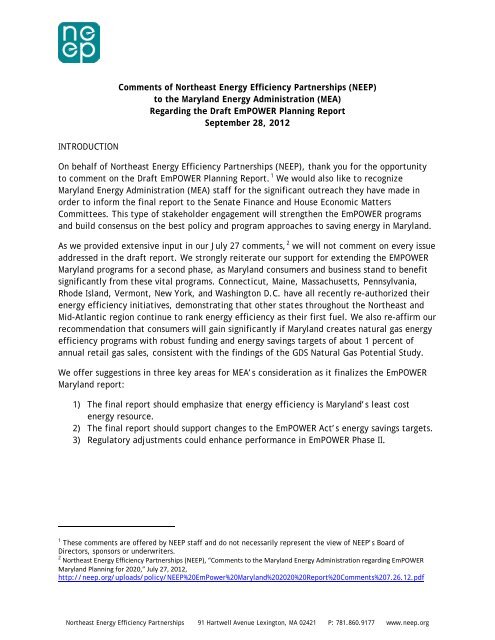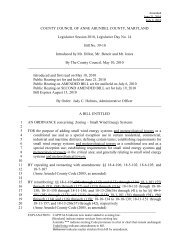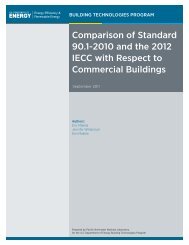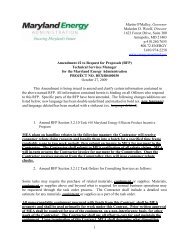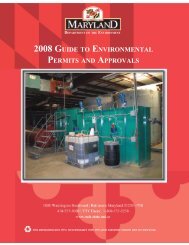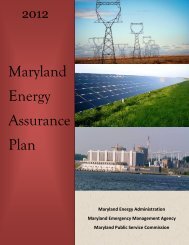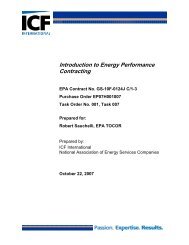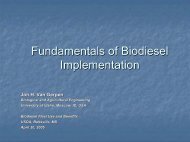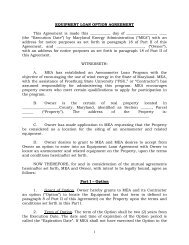Acknowledgement Title (Trebuchet MS Bold 15 pt) - Maryland ...
Acknowledgement Title (Trebuchet MS Bold 15 pt) - Maryland ...
Acknowledgement Title (Trebuchet MS Bold 15 pt) - Maryland ...
You also want an ePaper? Increase the reach of your titles
YUMPU automatically turns print PDFs into web optimized ePapers that Google loves.
NEEP Comments on EmPOWER Planning for 2020 Page 4 of 7The table below provides a brief comparison of how states through the Northeast and Mid-Atlantic regions design their energy efficiency savings targets and their respective energysavings performance in 2011.Table 1: How Northeast and Mid-Atlantic States Determine Savings Goals 9StateType of SavingsTargetWho Sets Target Funding Mechanism 2011 AnnualSavings (as % ofretail sales)ConnecticutAll Cost-EffectiveEfficiencyAnnual savings targets setby state utility commissionSystem Benefits Charge& ConservationAdjustment Mechanism1.30%MaineAll Cost-EffectiveEfficiencyAnnual savings targets setby state utility commissionFunding Capped byLegislature>1.0%MassachusettsAll Cost-EffectiveEfficiencyAnnual savings targets setby state utility commissionSystem Benefits Charge& Energy EfficiencyReconciliation Factor1.44%<strong>Maryland</strong>Energy EfficiencyResource Standard<strong>15</strong>% per capita savingstarget set by statuteEmPOWER <strong>Maryland</strong>Surcharge0.64%New HampshireNo binding savingstargetsNot applicable System Benefits Charge 0.59%New JerseyNo binding savingstargetEnergy Master Plan Goal of17% savings by 2020System Benefits Charge 0.56%New YorkEnergy EfficiencyPortfolio Standard(EEPS)<strong>15</strong>% energy savings targetby 20<strong>15</strong> set by state utilitycommissionSystem Benefits Charge 0.98%PennsylvaniaEnergy EfficiencyResource Standard~1% annual savings set bystatuteAct 129 Surcharge 1.20%Rhode IslandAll Cost-EffectiveEnergy EfficiencyAnnual savings set by stateutility commissionDemand-SideManagement Surcharge1.22%9 Data available from NEEP’s Energy Efficiency Policy Snapshot, Spring/Summer 2012, slide 5, online athttp://neep.org/uploads/policy/EE%20Policy%20Snapshot%20Updated-5.2.12.pdf.Northeast Energy Efficiency Partnerships 91 Hartwell Avenue Lexington, MA 02421 P: 781.860.9177 www.neep.org
NEEP Comments on EmPOWER Planning for 2020 Page 5 of 7VermontAll Cost-EffectiveEnergy EfficiencyAnnual savings set by stateutility commissionEnergy EfficiencyCharge1.98%While each state has a slightly different approach, a number of trends are clear. First, thehighest performing states have chosen an “all cost-effective efficiency” approach thatrequires their program administrators to invest in all energy efficiency resources that are lessexpensive than comparable energy supply o<strong>pt</strong>ions. Second, the most successful states havebinding energy efficiency savings targets in place, a practice that <strong>Maryland</strong> should continue.Finally, most states do not set their savings targets in statute, but rather through theregulatory process, allowing for flexibility to adjust savings targets and to evaluateperformance. MEA may consider it valuable to provide “all cost-effective efficiency” asanother o<strong>pt</strong>ion to present to lawmakers in its final report.Among the o<strong>pt</strong>ions presented, we favor a “bottom up” approach that sets binding, realistictargets that link utility performance to annual retail sales. Unlike the current per capitaconsum<strong>pt</strong>ion targets, this will ensure that program administrators are evaluated based uponthe strength of their programs rather than economic or weather factors beyond their control.Annual savings targets could be set by the Public Service Commission (PSC) as part of the nextthree-year EmPOWER plans, perhaps with the legislature setting a minimum target of 1 to 1.5percent of annual retail sales as guidance to the Commission.3) Regulatory changes could enhance performance in EmPOWER Phase II.Various stakeholders, including MEA, environmental groups, and the utilities broughtattention to the importance of putting in place the right regulatory framework to accompanyaggressive energy savings goals. Two regulatory matters, cost-effectiveness screening andutility shareholder performance incentives, deserve further consideration as <strong>Maryland</strong> movesinto EmPOWER Phase II.The draft report discusses the importance of proper cost-effectiveness screening to thesuccess of the EmPOWER programs, particularly the Total Resource Cost (TRC) test. 10 Thecritical issue is not primarily about who sets the test, but rather ensuring that the TRC test, ifit continues to be the main cost-effectiveness screening tool in <strong>Maryland</strong>, includes the fullrange of customer benefits as well as costs.A new report by the National Home Performance Council and Synapse Economics, entitled“Best Practices in Energy Efficiency Program Screening,” (see below, Figure 2) shows thatmany residential and low-income programs are not cost-effective unless the full range ofenergy, economic, health, and environmental benefits are taken into account (see the figurebelow for a full illustration). We highlight this in part because those residential and lowincomeprograms may be of particular importance to lawmakers and their constituents, who10 MEA, “EmPOWER Planning Draft Report,” p. 22-23.Northeast Energy Efficiency Partnerships 91 Hartwell Avenue Lexington, MA 02421 P: 781.860.9177 www.neep.org
NEEP Comments on EmPOWER Planning for 2020 Page 6 of 7stand to gain from greater access to energy efficiency programs. 11 This is also duly noted inthe report 12 , in citing the experiences in some other states – notably Massachusetts – thathave been able to initiate successful residential retrofit programs due in no small measure tothe fact that those programs have been allowed to screen as cost effective under that state’sregulatory review process. A more thorough examination of the link between costeffectivenessscreening and energy savings goal may be appropriate for a future technicalproceeding before the PSC.Figure 2: Cost-Effectiveness under Best Practices and Not-Best Practices (Synapse Economics,2012)Finally, many stakeholders raised the idea of shareholder performance incentives (SPIs) forutilities in their initial comments, though MEA has not currently addressed that in the draftreport. Given other priorities, it may be premature to discuss SPIs to reward exce<strong>pt</strong>ionalprogram performance. We note though that many jurisdictions around the region and thenation view a performance incentive mechanism as an essential element of their energyefficiency programs.Increasingly, other states are using SPIs as a policy tool to incentivize more costly energyefficiency measures that have larger long-time benefits to customers and reward innovativeprogram approaches. A recent report by ACEEE found a correlation between shareholder11 Tim Woolf, et al, Synapse Economics, “Best Practices in Energy Efficiency Program Screening: How to Ensure that the Value ofEnergy Efficiency is Properly Accounted For,” July 23, 2012, prepared for the National Home Performance Council, p. 4-5, 8,online at http://www.nhpci.org/images/NHPC_Synapse-EE-Screening_final.pdf.12 MEA, “EmPOWER Planning Draft Report,” p. 23.Northeast Energy Efficiency Partnerships 91 Hartwell Avenue Lexington, MA 02421 P: 781.860.9177 www.neep.org


